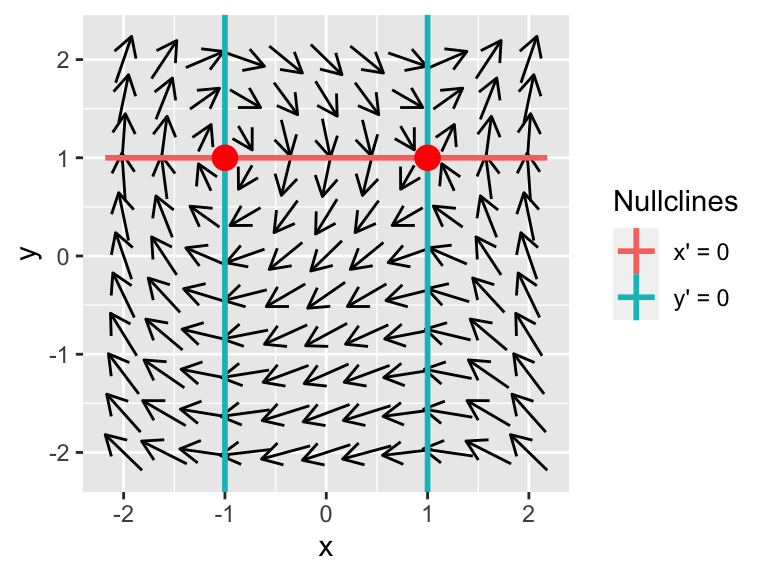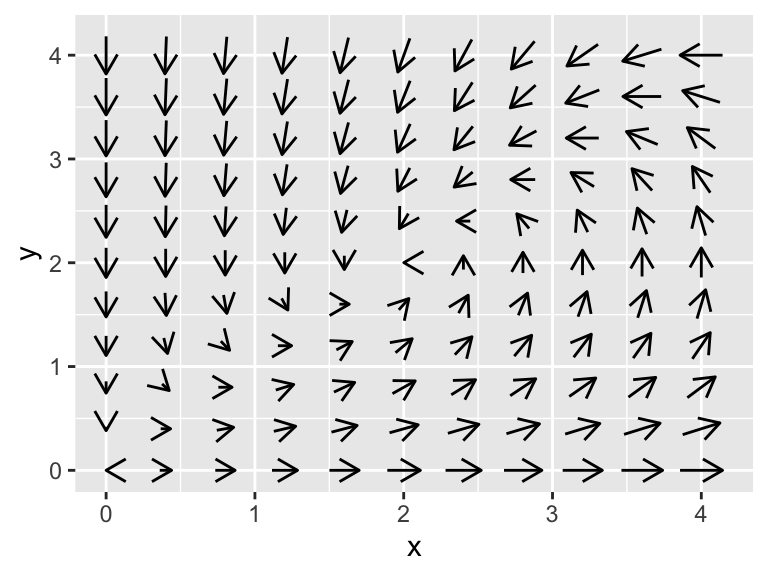16.1 Determining equilibrium solutions
To determine an equilbrium solutions for a system of differential equations we first need to find the intersection of different nullclines. We do this by setting each of the rate equations (\(\displaystyle \frac{dx}{dt}\) or \(\displaystyle \frac{dy}{dt}\)) equal to zero. Equation (16.1) has two nullclines:
\[\begin{equation} \begin{split} \frac{dx}{dt} = 0 &\rightarrow y-1 = 0\\ \frac{dy}{dt} = 0 & \rightarrow x^{2}-1 = 0 \end{split} \tag{16.2} \end{equation}\]
So solving for both nullclines in Equation (16.2) we have that \(y=1\) or \(x = \pm 1\). You can visually see the phaseplane with the nullclines in Figure 16.4.

Figure 16.4: Phaseplane for \(x'=y-1\) and \(y'=x^{2}-1\).
Remember: equilibrium solutions occur when two different nullclines intersect.
Let’s try another example:
\[\begin{equation} \begin{split} \frac{dx}{dt} &= x-0.5yx \\ \frac{dy}{dt} &= yx -y^{2} \end{split} \tag{16.3} \end{equation}\]
Figure 16.5 shows the phaseplane for this example. Can you guess where an equilibrium solution would be?

Figure 16.5: Phaseplane for \(x'=x-0.5xy\) and \(y'=yx=y^{2}\).
Let’s find the equations for the nullclines:
\[\begin{equation} \begin{split} \frac{dx}{dt} = 0 & \rightarrow x-0.5yx = 0 \\ \frac{dy}{dt} = 0 & \rightarrow yx -y^{2} = 0 \end{split} \end{equation}\]
The algebra is becoming a little more involved. Factoring \(x-0.5yx = 0\) we have \(x \cdot (1 - 0.5 y) = 0\), so either \(x=0\) or \(y=2\). Factoring the second equation we have \(y \cdot (x - y) = 0\), so either \(y=0\) or \(x=y\). Notice how this second nullcline is a function of \(x\) and \(y\).
For Equation (16.3) the equilibrium solutions are \((0,0)\), \((2,2)\). You may be tempted to think that \((0,2)\) is also an equilibrium solution - however - \(x=0\) and \(y=2\) are equations for the \(x\) nullcline. It is easy to forget, but equilibrium solutions are determined from the intersection of distinct nullclines.